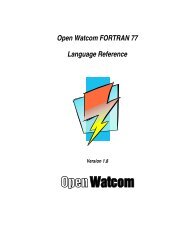Relocatable Object Module Format (OMF) Specification
Relocatable Object Module Format (OMF) Specification
Relocatable Object Module Format (OMF) Specification
You also want an ePaper? Increase the reach of your titles
YUMPU automatically turns print PDFs into web optimized ePapers that Google loves.
<strong>Relocatable</strong> <strong>Object</strong> <strong>Module</strong> <strong>Format</strong><br />
Frequent <strong>Object</strong> Record Subfields<br />
The contents of each record are determined by the record type, but certain subfields appear frequently enough to<br />
be explained separately. The format of such fields is below.<br />
Names<br />
A name string is encoded as an 8-bit unsigned count followed by a string of count characters, refered to as count,<br />
char format. The character set is usually some ASCII subset. A null name is specified by a single byte of 0<br />
(indicating a string of length 0).<br />
Indexed References<br />
Certain items are ordered by occurrence and are referenced by index. The first occurrence of the item has index<br />
number 1. Index fields may contain 0 (indicating that they are not present) or values from 1 through 7FFF. The<br />
index number field in an object record can be either 1 or 2 bytes long. If the number is in the range 0–7FH, the<br />
high-order bit (bit 7) is 0 and the low-order bits contain the index number, so the field is only 1 byte long. If the<br />
index number is in the range 80–7FFFH, the field is 2 bytes long. The high-order bit of the first byte in the field is<br />
set to 1, and the high-order byte of the index number (which must be in the range 0–7FH) fits in the remaining 7<br />
bits. The low-order byte of the index number is specified in the second byte of the field. The code to decode an<br />
index is:<br />
if (first_byte & 0x80)<br />
index_word = (first_byte & 7F) * 0x100 + second_byte;<br />
else<br />
index_word = first_byte;<br />
Type Indexes<br />
Type Index fields occupy 1 or 2 bytes and occur in PUBDEF, LPUBDEF, COMDEF, LCOMDEF, EXTDEF, and<br />
LEXTDEF records. These type index fields were used in old versions of the <strong>OMF</strong> to reference TYPDEF records.<br />
This usage is obsolete. This field is usually left empty (encoded as 1 byte with value 0). However some linkers<br />
may use this for debug information or other purposes.<br />
Ordered Collections<br />
Certain records and record groups are ordered so that the records may be referred to with indexes (the format of<br />
indexes is described in the "Indexed References" section). The same format is used whether an index refers to<br />
names, logical segments, or other items.<br />
The overall ordering is obtained from the order of the records within the file together with the ordering of repeated<br />
fields within these records. Such ordered collections are referenced by index, counting from 1 (index 0 indicates<br />
unknown or not specified).<br />
For example, there may be many LNAMES records within a module, and each of those records may contain many<br />
names. The names are indexed starting at 1 for the first name in the first LNAMES record encountered while<br />
reading the file, 2 for the second name in the first record, and so forth, with the highest index for the last name in<br />
the last LNAMES record encountered.<br />
2 <strong>OMF</strong> <strong>Specification</strong>, Version 1.1 Tool Interface Standards (TIS)
















